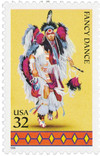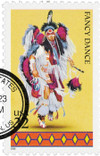
# 3072 - 1996 32c American Indian Dances: Fancy Dance
US #3072
1996 Fancy Dance
- Part of set of 5 picturing traditional dances
- Dances represent tribes from all over US
Stamp Category: Commemorative
Set: American Indian Dances
Value: 32¢, First-Class mail rate
First Day of Issue: June 7, 1996
First Day City: Oklahoma City, Oklahoma
Quantity Issued: 27,850,000
Printed by: Ashton-Potter (USA) Ltd.
Printing Method: Lithographed
Format: Panes of 20 (5 across, 4 down) from printing plates of 120 (8 across, 15 down)
Perforations: 11.1
Why the stamp was issued: This stamp is part of a set of five stamps issued to pay tribute to traditional Native American dances. The dances were chosen to represent different areas of the US.
About the stamp design: Keith Birdsong, an illustrator from Oklahoma, painted the stamp images using airbrush, acrylic, and colored pencils. These were the first stamp images Birdsong produced for the USPS, though he had previously designed souvenir envelopes.
The artist based his artwork for the American Indian Dance stamps on photos of dancers. The faces and costume details were changed to prevent portraying a living person on the stamp. The dances include: Fancy Dance, Butterfly Dance, Traditional Dance, Raven Dance, and Hoop Dance.
Special design details: The band at the bottom of each stamp is from digital clip art. USPS art director Carl Herrman added color to the black-and-white clip art.
First Day City: The First Day of Issue ceremony took place on the opening day of the Red Earth Native American Cultural Festival held in Oklahoma City. The festival includes juried art and dance competitions.
About the American Indian Dances set: The cultural heritage of Native Americans was celebrated on these stamps featuring five American Indian dances - the Fancy Dance, Butterfly Dance, Traditional Dance, Raven Dance, and Hoop Dance. The Traditional, Fancy, and Hoop dances are attributed to many tribes across the United States and are primarily performed at pow-wows. A ceremonial dance, the Raven Dance is only performed in the Pacific Northwest, while the Butterfly is performed by Southwest Pueblo tribes. Each stamp shows a Native American in traditional dress for each dance.
History the stamps represent: Fancy Dance: The Fancy Dance follows the Traditional Dance and is an adaptation of two western Oklahoma dances. The Grass Dance celebrated victory in war while the Ghost Dance, created after conquest by the Europeans, conjured up spirits and led to trances, enabling dancers to relive the good life of the past. The United States government prohibited both dances.
Combining and camouflaging the two dances, the Indians created a new dance that was quickly adopted by other tribes. Costumes became more and more elaborate as the many tribal contributions were incorporated. In time, the dance came to be called the Fancy Dance.
Today, Fancy Dancers wear face paint and garments laden with metallic beads, sequins, and ribbons, over which are worn elaborate feather bustles on the back, shoulder, and arms. Care is taken to elongate and color-coordinate the feathers that become an explosion of color and motion when dancers spin, twist, and leap.
Outfitted just as elaborately, the women celebrate their own Fancy Dance. As they jump and whirl to the fast beat of the drums, their long-fringed shawls come to life and look like exotic birds in flight.
Though modern, the Fancy Dance connects Native Americans with their rich and ancient culture.
US #3072
1996 Fancy Dance
- Part of set of 5 picturing traditional dances
- Dances represent tribes from all over US
Stamp Category: Commemorative
Set: American Indian Dances
Value: 32¢, First-Class mail rate
First Day of Issue: June 7, 1996
First Day City: Oklahoma City, Oklahoma
Quantity Issued: 27,850,000
Printed by: Ashton-Potter (USA) Ltd.
Printing Method: Lithographed
Format: Panes of 20 (5 across, 4 down) from printing plates of 120 (8 across, 15 down)
Perforations: 11.1
Why the stamp was issued: This stamp is part of a set of five stamps issued to pay tribute to traditional Native American dances. The dances were chosen to represent different areas of the US.
About the stamp design: Keith Birdsong, an illustrator from Oklahoma, painted the stamp images using airbrush, acrylic, and colored pencils. These were the first stamp images Birdsong produced for the USPS, though he had previously designed souvenir envelopes.
The artist based his artwork for the American Indian Dance stamps on photos of dancers. The faces and costume details were changed to prevent portraying a living person on the stamp. The dances include: Fancy Dance, Butterfly Dance, Traditional Dance, Raven Dance, and Hoop Dance.
Special design details: The band at the bottom of each stamp is from digital clip art. USPS art director Carl Herrman added color to the black-and-white clip art.
First Day City: The First Day of Issue ceremony took place on the opening day of the Red Earth Native American Cultural Festival held in Oklahoma City. The festival includes juried art and dance competitions.
About the American Indian Dances set: The cultural heritage of Native Americans was celebrated on these stamps featuring five American Indian dances - the Fancy Dance, Butterfly Dance, Traditional Dance, Raven Dance, and Hoop Dance. The Traditional, Fancy, and Hoop dances are attributed to many tribes across the United States and are primarily performed at pow-wows. A ceremonial dance, the Raven Dance is only performed in the Pacific Northwest, while the Butterfly is performed by Southwest Pueblo tribes. Each stamp shows a Native American in traditional dress for each dance.
History the stamps represent: Fancy Dance: The Fancy Dance follows the Traditional Dance and is an adaptation of two western Oklahoma dances. The Grass Dance celebrated victory in war while the Ghost Dance, created after conquest by the Europeans, conjured up spirits and led to trances, enabling dancers to relive the good life of the past. The United States government prohibited both dances.
Combining and camouflaging the two dances, the Indians created a new dance that was quickly adopted by other tribes. Costumes became more and more elaborate as the many tribal contributions were incorporated. In time, the dance came to be called the Fancy Dance.
Today, Fancy Dancers wear face paint and garments laden with metallic beads, sequins, and ribbons, over which are worn elaborate feather bustles on the back, shoulder, and arms. Care is taken to elongate and color-coordinate the feathers that become an explosion of color and motion when dancers spin, twist, and leap.
Outfitted just as elaborately, the women celebrate their own Fancy Dance. As they jump and whirl to the fast beat of the drums, their long-fringed shawls come to life and look like exotic birds in flight.
Though modern, the Fancy Dance connects Native Americans with their rich and ancient culture.












